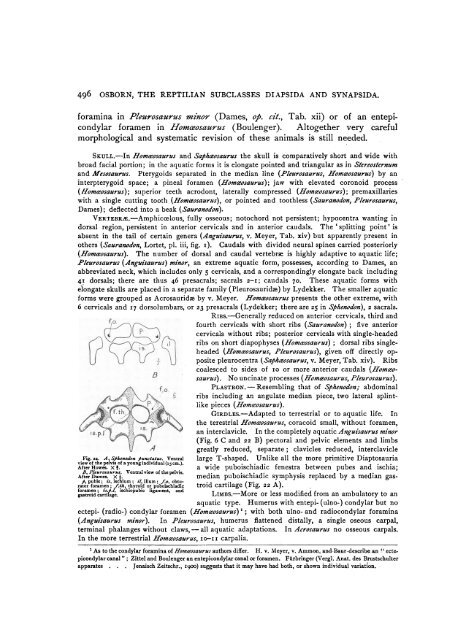American Museum of Natural History
American Museum of Natural History
American Museum of Natural History
Create successful ePaper yourself
Turn your PDF publications into a flip-book with our unique Google optimized e-Paper software.
496 OSBORN, THE REPTILIAN SUBCLASSES DIAPSIDA AND SYNAPSIDA.<br />
foramina in Pleurosaurus minor (Dames, op. cit., Tab. xii) or <strong>of</strong> an entepicondylar<br />
foramen in Homaosaurus (Boulenger). Altogether very careful<br />
morphological and systematic revision <strong>of</strong> these animals is still needed.<br />
SKULL.-In Romawosaurus and Saphaosaurus the skull is comparatively short and wide with<br />
broad facial portion; in the aquatic forms it is elongate pointed and triangular as in Stereosternum<br />
and Mesosaurus. Pterygoids separated in the median line (Pleurosaurus, Homwrosaurus) by an<br />
interpterygoid space; a pineal foramen (Homeosaurus); jaw with elevated coronoid process<br />
(FZomweosaurus); superior teeth acrodont, laterally compressed (Homaeosaurus); premaxillaries<br />
with a single cutting tooth (Homeosaurus), or pointed and toothless (Sauranodon, Pleurosaurus,<br />
Damies); deflected into a beak (Sauranodon).<br />
VERTEBRX.-Amphiccelous, fully osseous; notochord not persistent; hypocentra wanting in<br />
dorsal region, persistent in anterior cervicals and in anterior caudals. The 'splitting point' is<br />
absent in the tail <strong>of</strong> certain genera (Anguisaurus, v. Meyer, Tab. xiv) but apparently present in<br />
others (Sauranodon, Lortet, pl. iii, fig. i). Caudals with divided neural spines carried posteriorly<br />
(Homawosaurus). The number <strong>of</strong> dorsal and caudal vertebrae is highly adaptive to aquatic life;<br />
Pleurosaurus (Anguisaurus) minor, an extreme aquatic form, possesses, according to Dames, an<br />
abbreviated neck, which includes only 5 cervicals, and a correspondingly elongate back including<br />
41 dorsals; there are thus 46 presacrals; sacrals 2-I; caudals 7o. These aquatic forms with<br />
elongate skulls are placed in a separate family (Pleurosauridae) by Lydekker. The smaller aquatic<br />
forms were grouped as Acrosauride by v. Meyer. Homweosaurus presents the other extreme, with<br />
6 cervicals and 17 dorsolumbars, or 23 presacrals (Lydekker; there are 25 in Sphenodon), 2 sacrals.<br />
RIBs.-Generally reduced on anterior cervicals, third and<br />
f;o ( fourth cervicals with short ribs (Sauranodon); five anterior<br />
cervicals without ribs; posterior cervicals with single-headed<br />
ribs on short- diapophyses (Homxosaurus); dorsal ribs singleheaded<br />
(Homaeosaurus, Pleurosaurus), given <strong>of</strong>f directly opposite<br />
pleurocentra (Sapheosaurus, v. Meyer, Tab. xiv). Ribs<br />
coalesced to sides <strong>of</strong> IO or more anterior caudals (Homceosaurus).<br />
No uncinate processes (Jfomeosaurus, Pleurosaurus).<br />
f~o ( :PLASTRON.- Resembling that <strong>of</strong> Sphenodon; abdominal<br />
ribs including an angulate median piece, two lateral splintlike<br />
pieces (Homawosaurus).<br />
GIRDLES.-Adapted to terrestrial or to aquatic life. In<br />
the terestrial Hoinaeosaurus, coracoid small, without foramen,<br />
S.pA ; w5 r an interclav-icle. In the completely aquatic Anguisaurus minor<br />
(Fig. 6 C and 22 B) pectoral and pelvic elements and limbs<br />
tJ A greatly reduced, separate; clavicles reduced, interclavicle<br />
Fig. 22. A Shenodon hunctatus. Ventral large T-shaped. Unlike all the more prirnitive Diaptosauria<br />
view <strong>of</strong> thepepis<br />
<strong>of</strong> a young individual(ub<br />
cm.).<br />
After Howes. X o. a wide puboischiadic fenestra between pubes and ischia;<br />
B Pleurosaurus. Ventralview <strong>of</strong> thepelvis. .<br />
After Dames. Xi. median puboiscbiadic symphysis replaced by a median gas-<br />
fi, pubis; is, ischium; il, ilium; f.o, obturator<br />
foramen; f.th, thyroid or puboischiadic troid cartilage (Fig. 22 A).<br />
foramen; is.j.i, ischiopubic ligament, and<br />
gastroid cartilage. LIMBS.-More or less modified from an ambulatory to an<br />
aquatic type. Humerus with entepi- (ulno-) condylar but no<br />
ectepi- (radio-) condylar foramen (Homatosaurus) 1; with both ulno- and radiocondylar foramina<br />
(Anguisaurus minor). In Pleurosaurus, humerus flattened distally, a single oseous carpal,<br />
terminal phalanges without claws, all aquatic adaptations. In Acrosaurus no osseous carpals.<br />
In the more terrestrial Homceosaurus, Io-i i carpalia.<br />
I As to the condylar foramina <strong>of</strong> Homnceosaurus authors differ. H. v. Meyer, v. Ammon, and--Baur-describe an "-' ectepicondylar<br />
canal "; Zittel and Boulenger an entepicondylar canal or foramen. Furbringer (Vergl. Anat. des Brustschulter<br />
apparates . . . Jenaisch Zeitschr., I9oo) suggests that it may have had both, or shown individual variation.

















